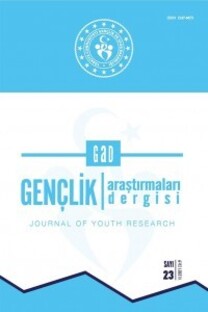Africa’s Reductive Images, Contesting the Sources, and New Generations as Passive Victims: A Reflection on Historical and Global Representational Practices
Afrika’nın İndirgemeci İmajları, Kaynakları Sorgulamak ve Pasif Bir Kurban olarak Yeni Kuşaklar: Tarihi ve Küresel Temsili Pratikler Üzerinde Bir Değerlendirme
___
- • Blake, M. (2013). Worlds apart: Uganda tops list of most ethnically diverse countries on Earth while South Korea comes bottom. Daily Mail Online. Retrieved from http://www.dailymail.co.uk/news/article-2326136.
- • Brooks, M. D. (2013). Civilizing the metropole: The role of the 1889 Parisian universal exposition’s colonial exhibits in creating greater France. The University of Central Florida undergraduate Research Journal, 6(2), pp. 71-81.
- • Chandra, R. (2004). Communication Media and Social Change. Delhi: Isha Books.
- • Chang, H.Y. (2013). To View Two Views: A Case Study of Cross-Cultural Communication in Museum Exhibitions. New York: ProQuest LLC.
- • Confino, A. (1997). Collective memory and cultural history: Problems of method. The American Historical Review, 102 (5), pp. 1386-1403.
- • Corbey, R. (1993). Ethnographic showcases, 1870-1930. American Anthropological Association, Cultural Anthropology, 8(3), pp. 338-369.
- • Debalke, T. (2016, February 02). Corporate council on Africa or corruption council for African authoritarian regimes? Retrieved from http://ecadforum.com/2016/02/02/corporate-council-on-africa-or-corruption-council.
- • Fanon, F. (1967). Black skin, white masks. Translated by Charles Lam Markmann. London: Pluto Press
- • Gilman, S. L. (1985). Black bodies, white bodies: Towards an iconography of female sexuality in late nineteenth-century arts, medicine, and literature. Chicago Journals, Critical Inquiry, 12 (1), pp. 204-242.
- • Hall, S. (1997). Representation: Cultural representations and signifying practices. London: Sage Publications.
- • Harry, I. (2015). Revisiting the new world information and communication order dialectic using Nigerian newspapers directional focus as case study. New Media and Mass Communication, 35, pp. 73-84.
- • Korasick, J. E. (2005). Collecting Africa: African material culture displays and the American image of Africa, 1885-1930. New York: ProQuest.
- • Lindfors, B. (2001). Hottentot, Bushman, Kaffir: The making of racist stereotypes in 19th-century Britain. In Palmberg, M. (Eds.), Encounter images in the meetings between Africa and Europe (pp. 54 -75). Borås: Centraltryckeriet Åke Svenson AB.
- • Marx, K. (1976). Capital: A critique of political economy: Volume one. London: Hazell, Watson & Viney Ltd.
- • McCombs M.E. & Shaw D. L. (1979). The Agenda-setting function of mass media. The Public Opinion Quarterly, 36 (2), pp. 176-187. Oxford: Oxford University Press.
- • Mezzana D. (2005). A cancerous image: The causes of Africa’s negative and reductive image. African Societies. Two-Monthly E-Magazine on the Invisible Africa. Retrieved from http://cyber.law.harvard.edu/ digitaldemocracy.
- • Pitchford, S. (2008). Identity tourism: Imaging and imagining the nation. West Yorkshire: Emerald Group Publishing Said, E. W. (1978). Orientalism. New York: Vintage Books, A Division of Random House.
- • Sanchez-Gómez L. (2009). Imperial faith and catholic missions in the grand exhibitions of the Estado Novo. Analise Social, 44(193), pp. 671-692.
- • Schiffman, R. (2013). Hunger, food security, and the African land grab. Retrieved from http://voiceseducation.org/node/7873.
- • Selwyn-Holmes, A. (2009, August 12). Vulture stalking a child. Retrieved from https://iconicphotos. org/2009/08/12/.
- • Servaes, J. (2002). Communication for development: One world, multiple cultures. New Jersey: Hampton Press.
- • Servaes, J. (2007). Harnessing the UN system into a common approach on communication for development. Los Angeles: Sage Publications.
- • The true size of Africa. (2013, n.d.). Inside/Out. Retrieved from http://insideoutpaper.org/the-true-sizeof-africa (2013).
- • Tomaseilli, K.G. (2007). Mediterranean chic; video and development. Studies in Documentary Film, 1(3), pp. 297-317.
- • Turvill, W. (2013). Africa as you’ve never seen it before: Clever comparison shows it’s really as big as China, India, the United States AND most of Europe put together. Mail Online. Retrieved from http://www. dailymail.co.uk/news/article-2445615.
- ISSN: 2147-8473
- Yayın Aralığı: 3
- Başlangıç: 2012
- Yayıncı: T.C. Gençlik ve Spor Bakanlığı Eğitim, Kültür ve Araştırma genel Müdürlüğü
Aylin YALÇIN IRMAK, Meryem METİNOĞLU
Fransa’da Yurttaşlık Eğitimi ve Gençlik
Rethinking Youth Participation For Social Development and Community Strengthening
Toplumsal Gelişme ve Toplumun Güçlendirilmesi Konusunda Gençliğin Katılımı Üzerine Yeniden Düşünmek
A Research About the Youngs’ Voting Behavior in Local Elections: Metropolitan Municipality Election
